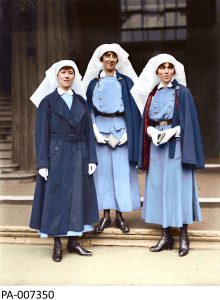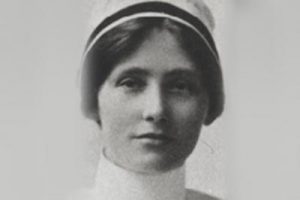One of the things I love about writing historical fiction is all the neat research I get to do. A ton of it never makes it even close to the story, but it does help me immerse myself in the period and the lives of my characters.

(Library and Archives Canada Photo, MIKAN No. 3395710)
While I still wait for all the official stuff with my first historical release, I thought I’d give a little BTS glimpse into one of my research topics: Canadian Bluebirds.
Bluebirds were WW1 Nursing Sisters and so named because of their uniform – generally a blue dress with a white apron and the somewhat cumbersome nursing veil… can you imagine having to wear something like this all day? (I’m thinking they must have itched like crazy!) They served both overseas and at home (for a great story featuring a war nurse at the front, check out BLUEBIRD by Genevieve Graham). My main character, Nora Crowell, did her training at the Victoria General in Halifax, and when the story opens in the fall of 1917, she’s serving at Camp Hill Hospital – a brand new hospital in Halifax, Nova Scotia, that cared for convalescing soldiers returning home from the front.
In researching nursing at home, I came across some stories of real women who fulfilled this role, and I gave a few of them walk-on roles during the time of the Halifax Explosion. One is Jessie Smiley. Jessie also trained at the VG and served overseas in England. At the time of the explosion, she was at Camp Hill Hospital. Because she’d worked with Ear, Nose, and Throat patients in England, she was well-suited for treating the facial injuries suffered by so many explosion victims. Another walk-on role is Matron Cotton. I took some liberties here; Dorothy Cotton actually did not return to serve at Camp Hill until 1918, after a varied and incredibly distinguished service during the war – including being in Petrograd and witnessing the revolution.

Jessie Smiley, VG School of Nursing 1915, VG Nursing Archives
Not to be forgotten are the VADs – Voluntary Aid Detachment workers. These first-aid trained women worked at the hospital fulfilling more menial roles such as making beds, seeing to soldiers’ comforts, serving meals. The line almost seems a little blurred with the nurses at times as nurses were often not permitted to perform many tasks. But as the saying goes, necessity breeds invention. “Before the explosion, nurses could only do what doctors said they could do. After the explosion, the need was so great, they were doing things they had never done before, like removing glass, and suturing wounds. Nurses got together and said, ‘We can do more.’” (Gloria Stephens, VG Nursing Archives) Nora, my main character, has a fair hand at suturing – something she’s never done outside of her training before.
To be a nursing sister, a woman had to be single, between the ages of 21 and 38, a British subject (which Canadians were) and trained at a qualified nursing school. And while they carried the title “Sister,” they were not associated with any religious order. Canada was also the only country to give the nursing sisters a rank; they held the rank of lieutenant.
If a woman married, she was required to resign her commission. Let’s just say that that policy led to secrets sometimes being kept… including a secret in my story.

